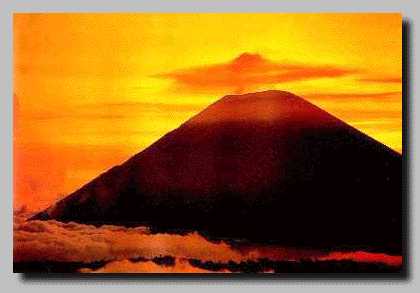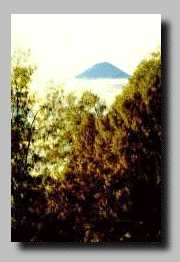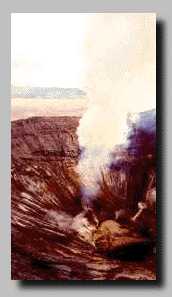Bromo
- Tengger - Semeru
The
summit of Mt. Semeru (3676m), Java's highest peak, seen from Mt.Penanjakan
at sunset
 |
|
The
Bromo - Tengger - Semeru National Park covers some 800 square
kilometres in the centre of East Java. It is the largest volcanic
region in the province and contains the island's highest mountain,
Semeru, which rises 3,676 metres above sea - level. The ten kilometre
wide 'sand sea' of Bromo has become East Java's most famous attraction.
The Park is home to quite a number of rare and protected plants,
among them the dwarf shrub styphelia javanica (L.) with its fragrant
white flowers, as well as a special type of rhododendron. Higher
mountain regions are covered in hardy cemara (casuarina)
trees, while the lower slopes are used partially for commercial
forest plantations. The range of fauna here has not been fully
recorded, though a few species, such as the wild pig, Timorese
deer and muncak (barking deer) exist in considerable numbers.
There are also leopards, flying squirrels and a variety of duck
and other waterfowl. |
Mt.
Semeru

|
|
The
Bromo/Semeru region is inhabited by the Tenggerese, who to this
day retain a Hindu/Javanese faith. Isolated for centuries, they
have remained loyal to the old ways and practice a religion which
is almost identical to that found on neighbouring Bali. A centre
for traditional Tenggerese culture is at Wonokitri, where a large
Hindu temple has been built quite recently. The Park is accessible
from four directions; from Probolinggo, Pasuruan, Lumajang or
Malang. The most popular approach is from the north coastal town
of Probolinggo, from where the road winds up through Sukapura to Ngadisari. An alternative route leads from Pasuruan, via Tosari
to the summit of Mt. Penanjakan, which is rapidly becoming a
favourite spot to welcome the dawn. Accommodation can be found
at both Ngadisari and Tosari.
|
Bromo;
looking into the crater

|
|
As the
sun rises, the early morning mist dissipates to reveal a fantastic,
almost lunar landscape. Two deeply furrowed volcanic cones stand
side by side on a vast, perfectly flat expanse of sand ten kilometres
across. Bromo's crater is active, emitting dense clouds of sulphureous
steam. Reasonably quiescent at the moment,the mountain has erupted
three times during this century at fairly regular thirty year
intervals. The last major eruption was in 1974. Beside Bromo
stands its dormant twin, Mt.Batok, whose sides rise in a perfect
cone shape to a flat summit. The entire plain is surrounded by
steep cliffs, which form the rim of an enormous caldera.
|

